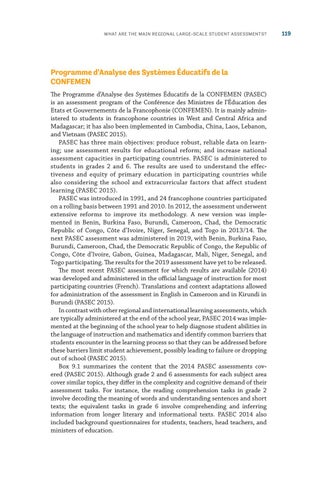What Are the Main Regional Large-Scale Student Assessments?
Programme d’Analyse des Systèmes Éducatifs de la CONFEMEN The Programme d’Analyse des Systèmes Éducatifs de la CONFEMEN (PASEC) is an assessment program of the Conférence des Ministres de l’Éducation des Etats et Gouvernements de la Francophonie (CONFEMEN). It is mainly administered to students in francophone countries in West and Central Africa and Madagascar; it has also been implemented in Cambodia, China, Laos, Lebanon, and Vietnam (PASEC 2015). PASEC has three main objectives: produce robust, reliable data on learning; use assessment results for educational reform; and increase national assessment capacities in participating countries. PASEC is administered to students in grades 2 and 6. The results are used to understand the effectiveness and equity of primary education in participating countries while also considering the school and extracurricular factors that affect student learning (PASEC 2015). PASEC was introduced in 1991, and 24 francophone countries participated on a rolling basis between 1991 and 2010. In 2012, the assessment underwent extensive reforms to improve its methodology. A new version was implemented in Benin, Burkina Faso, Burundi, Cameroon, Chad, the Democratic Republic of Congo, Côte d’Ivoire, Niger, Senegal, and Togo in 2013/14. The next PASEC assessment was administered in 2019, with Benin, Burkina Faso, Burundi, Cameroon, Chad, the Democratic Republic of Congo, the Republic of Congo, Côte d’Ivoire, Gabon, Guinea, Madagascar, Mali, Niger, Senegal, and Togo participating. The results for the 2019 assessment have yet to be released. The most recent PASEC assessment for which results are available (2014) was developed and administered in the official language of instruction for most participating countries (French). Translations and context adaptations allowed for administration of the assessment in English in Cameroon and in Kirundi in Burundi (PASEC 2015). In contrast with other regional and international learning assessments, which are typically administered at the end of the school year, PASEC 2014 was implemented at the beginning of the school year to help diagnose student abilities in the language of instruction and mathematics and identify common barriers that students encounter in the learning process so that they can be addressed before these barriers limit student achievement, possibly leading to failure or dropping out of school (PASEC 2015). Box 9.1 summarizes the content that the 2014 PASEC assessments covered (PASEC 2015). Although grade 2 and 6 assessments for each subject area cover similar topics, they differ in the complexity and cognitive demand of their assessment tasks. For instance, the reading comprehension tasks in grade 2 involve decoding the meaning of words and understanding sentences and short texts; the equivalent tasks in grade 6 involve comprehending and inferring information from longer literary and informational texts. PASEC 2014 also included background questionnaires for students, teachers, head teachers, and ministers of education.
119

